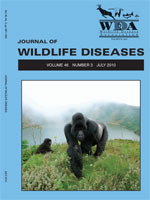Serologic testing to detect antibodies to avian influenza (AI) virus has been an underused tool for the study of these viruses in wild bird populations, which traditionally has relied on virus isolation and reverse transcriptase-polymerase chain reaction (RT-PCR). In a preliminary study, a recently developed commercial blocking enzyme-linked immunosorbent assay (bELISA) had sensitivity and specificity estimates of 82% and 100%, respectively, for detection of antibodies to AI virus in multiple wild bird species after experimental infection. To further evaluate the efficacy of this commercial bELISA and the agar gel immunodiffusion (AGID) test for AI virus antibody detection in wild birds, we tested 2,249 serum samples collected from 62 wild bird species, representing 10 taxonomic orders. Overall, the bELISA detected 25.4% positive samples, whereas the AGID test detected 14.8%. At the species level, the bELISA detected as many or more positive serum samples than the AGID in all 62 avian species. The majority of positive samples, detected by both assays, were from species that use aquatic habitats, with the highest prevalence from species in the orders Anseriformes and Charadriiformes. Conversely, antibodies to AI virus were rarely detected in the terrestrial species. The serologic data yielded by both assays are consistent with the known epidemiology of AI virus in wild birds and published reports of host range based on virus isolation and RT-PCR. The results of this research are also consistent with the aforementioned study, which evaluated the performance of the bELISA and AGID test on experimental samples. Collectively, the data from these two studies indicate that the bELISA is a more sensitive serologic assay than the AGID test for detecting prior exposure to AI virus in wild birds. Based on these results, the bELISA is a reliable species-independent assay with potentially valuable applications for wild bird AI surveillance.
How to translate text using browser tools
1 July 2010
PREVALENCE OF ANTIBODIES TO TYPE A INFLUENZA VIRUS IN WILD AVIAN SPECIES USING TWO SEROLOGIC ASSAYS
Justin D. Brown,
M. Page Luttrell,
Roy D. Berghaus,
Whitney Kistler,
Shamus P. Keeler,
Andrea Howey,
Benjamin Wilcox,
Jeffrey Hall,
Larry Niles,
Amanda Dey,
Gregory Knutsen,
Kristin Fritz,
David E. Stallknecht
ACCESS THE FULL ARTICLE

Journal of Wildlife Diseases
Vol. 46 • No. 3
July 2010
Vol. 46 • No. 3
July 2010
AGID
antibodies
avian influenza virus
blocking
enzyme-linked immunosorbent assay
serology
wild birds




